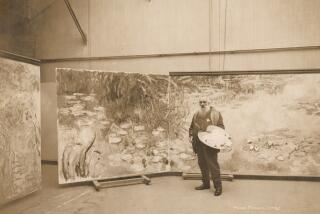Was Blue the Only Hue Monet Could See? : Poor Vision May Have Colored Art
CHICAGO — Late in his life, French impressionist Claude Monet, who died in 1926, produced a series of paintings most notable for the fact that they were very, very blue.
He may have been trying to make an artistic statement, or capture a particular mood. Or the reason the canvases were blue could have been because that was the only color Monet could see.
Dr. James Ravin, an ophthalmologist with an undergraduate degree in art history, has spent five years studying how Monet’s failing eyesight and visual difficulties affected his later work. He has consulted Monet’s letters to his eye surgeon, talked with art historians and examined a pair of Monet’s glasses.
In an article published in the Journal of the American Medical Assn., Ravin discusses this influence on an acknowledged leader of the impressionist movement.
Cataracts Important
“The cataracts that blinded Monet were an important influence on the way he saw the world and the way he painted it,” the article concludes.
Monet’s visual difficulties first became apparent when he was in his 60s, Ravin said, when his loose impressionist style began to blur even further. By 1918, Monet wrote a note to a Paris eye doctor to complain of the change.
“I no longer perceived colors with the same intensity,” he wrote, “I no longer painted light with the same accuracy. Reds appeared muddy to me, pinks insipid and the intermediate and lower tones escaped me.”
Monet soon was forced to label tubes of paint in order to distinguish colors. In 1922 blues had disappeared from his paintings in favor of red and yellow. That year he was pronounced blind and was encouraged to undergo cataract surgery.
Long Convalescence
A long convalescence followed the surgery, because techniques were not nearly as sophisticated as they are today.
“If he would have had surgery today,” Ravin said in a telephone interview from his home in Toledo, Ohio, “he would have been rehabilitated quicker. He could have been out and painting in two weeks.”
Monet noticed a dramatic change after the operation. The cataracts, which had formed a yellow-brown filter on his right eye, had been removed, and now “Monet was able to see colors he had not seen for years, particularly violet and blue tones.”
Ravin explains that similar to a person who has been in darkness for a long time and then goes out into the sun, Monet saw the new colors as brighter than they were.
‘Annoys Me Terribly’
“I see blue,” Monet told his physician in 1924, a year and a half after he had cataracts removed from his right eye. “I no longer see red or yellow. This annoys me terribly, because I know these colors exist.
“It’s filthy. It’s disgusting. I see nothing but blue.”
Monet was not pleased with the blue paintings he created during this period, Ravin said, and wanted to destroy them. Monet eventually overcame the color difficulties by using glasses with tinted lenses, and lived to finish a major series of paintings for the French government.
The blurred paintings that Monet created as his eyes deteriorated were not highly thought of at the time, Ravin said, but are now seen as a link to 20th-Century abstract art.
May Have Doubters
He admits that this interpretation might not sit too well with those who study art for art’s sake.
“When you talk about art historians evaluating this, they don’t know quite what to do,” Ravin said.
And indeed, Richard Brettell, curator of European paintings and sculptures for the Art Institute in Chicago, said: “No one historically has dealt with this very much. I think art historians would have a tendency to resist this type of explanation.”
“We have a tendency to believe that every aspect in a work of art is an act of will.”
Brettell disputes the notion that Monet painted blue because that was the “only color he saw.”
Symbolic Meaning
“Monet was very interested in the symbolic meaning of color,” Brettell said. “He was interested in the mood of color, the meaning of color. He knew he had perceptual problems, and if he wanted to correct for them, he could have.”
“Since the 1880s,” Brettell said, “there’s been a huge separate bibliography springing up by scientists and doctors on artists.” He said that most art historians dispute and dislike such scientific explanations as oversimplifying the issue of artistic creation.
More to Read
The biggest entertainment stories
Get our big stories about Hollywood, film, television, music, arts, culture and more right in your inbox as soon as they publish.
You may occasionally receive promotional content from the Los Angeles Times.










